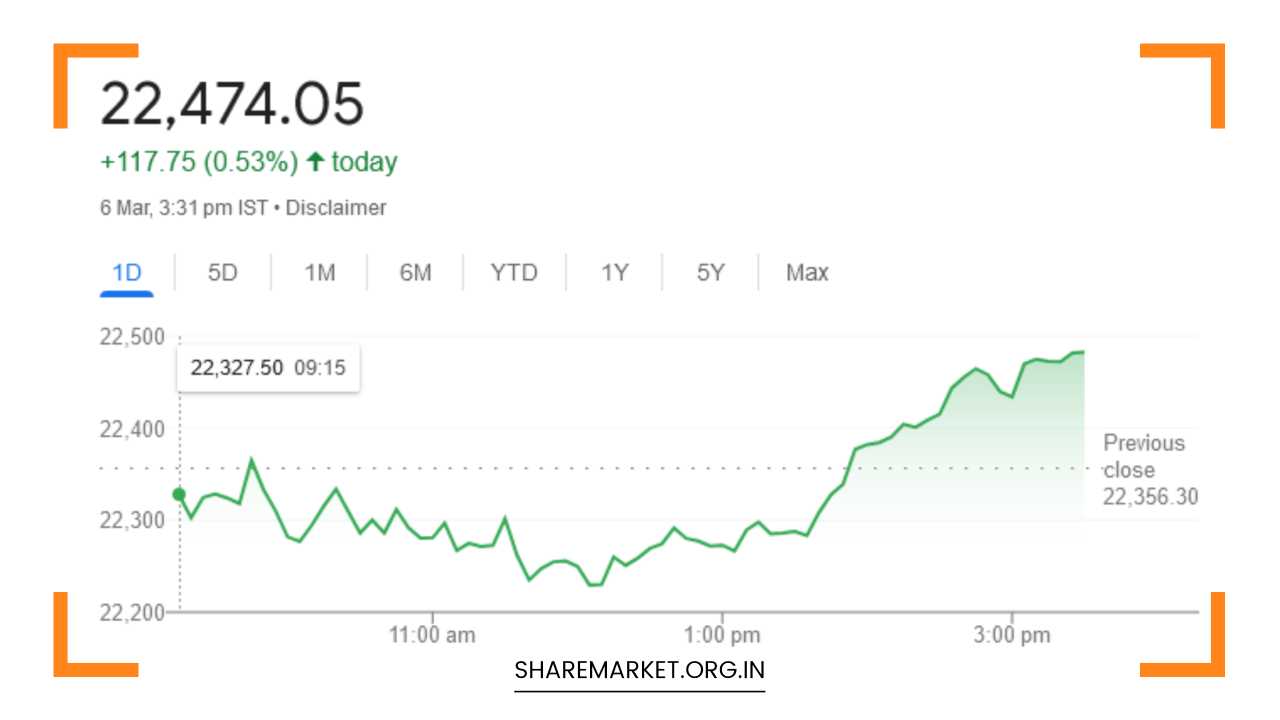Nifty Closed at 22,474; Nifty Prediction for Tomorrow

Nifty Prediction for Tomorrow
Impressive Gains Amidst Market Volatility: A Deep Dive into the March 6 Trading Session
In a highly volatile trading session on March 6, Indian benchmark indices displayed remarkable resilience and closed at new record highs.
The Sensex and Nifty concluded at 74,085.99 (up 408.86 points or 0.55%) and 22,474.00 (up 117.70 points or 0.53%), respectively.
This surge highlighted the dynamic nature of the Indian stock market, characterized by significant fluctuations and diverse sectoral performances.
Market Dynamics: A Closer Look
The trading day witnessed 508 shares recording gains, 2820 shares experiencing declines, and 53 shares remaining unchanged.
However, beneath the surface, small and medium-sized stocks faced notable pressure. The BSE Midcap index closed down 0.6%, and the Smallcap index was down 2%, indicating varying performances within the market segments.
Examining the top gainers and losers in Nifty provides insights into the day’s market dynamics. Notable gainers included Bajaj Auto, Kotak Mahindra Bank, Axis Bank, Bharti Airtel, and SBI Life Insurance.
Conversely, Adani Enterprises, UltraTech Cement, NTPC, ONGC, and BPCL found themselves among the top losers, underscoring the nuanced dynamics at play.
Sectoral Indices: Varied Performances
Delving into sectoral indices, the banking index showed a robust 1% increase, while the pharma and IT indices posted a commendable 0.7% growth.
On the flip side, the oil and gas, electricity, and realty sectors collectively faced a 1% decline, emphasizing the sector-specific variations that shaped the day’s market dynamics.
Market Outlook for March 7: Analyst Perspectives
As investors look ahead to March 7, market analysts offer insights into potential trajectories. Aditya Gaggar, Director of Progressive Shares, observed significant ups and downs in the day’s business.
The morning session saw bearish dominance, with substantial losses in the mid and smallcap segments impacting market sentiment.
However, a notable reversal occurred in the latter half of the trading session, driven by a surge in banking stocks, enabling the index to overcome the earlier pressure. Gaggar emphasized the sharp recovery in leading stocks, contributing to the market reaching new highs.
On the daily chart, Nifty showcased its resilience by defending the support at 22,300 and forming a bullish engulfing pattern, indicative of potential upward momentum.
Gaggar projected a target range of 22,600-22,650 for Nifty, highlighting a robust support level at 22,300. The technical analysis provided a positive outlook, signaling optimism for investors eyeing potential opportunities in the market.
Ajit Mishra, from Religare Broking, contributed further insights, pointing to rotational buying across sectors as a key factor supporting the positive trend.
The diverse participation in the market by different sectors, he noted, has played a pivotal role in maintaining an overall positive trajectory. Mishra projected a potential level of 22,800 for Nifty, underscoring the optimism prevalent in the market.
However, amidst the positive outlook, broader market concerns should not be ignored. The prevailing uncertainties warrant caution, particularly in smallcap counters.
Mishra advised investors engaging in long trades to prioritize significant indices and major midcaps while adopting a risk-averse approach with smallcaps.
Balancing Optimism and Prudence: A Crucial Approach
This cautious sentiment aligns with the broader market sentiments, where uncertainties and external factors can influence the market trajectory.
As investors navigate the dynamic landscape, it becomes crucial to strike a balance between optimism and prudence, considering both short-term market movements and long-term investment goals.
Market as a Reflection of Economic Landscape
The Indian stock market, with its intricate interplay of factors, reflects the broader economic landscape and investor sentiment. Each trading session becomes a microcosm of the larger financial ecosystem, shaped by global events, economic indicators, and investor behaviors.
The diverse performances of sectors and individual stocks provide a nuanced narrative, offering investors a rich tapestry to analyze and make informed decisions.
The Broader Economic Implications: A Macro Perspective
Understanding the implications of the market’s performance extends beyond the immediate gains and losses on a given trading day. It provides a lens through which to analyze the broader economic landscape, offering insights into investor sentiment, corporate performance, and the overall health of the financial ecosystem.
The robust performance of banking stocks and the bullish trend in certain sectors indicate underlying economic strengths. Banking, being a key driver of economic activity, often reflects the health of businesses and consumer spending.
The surge in banking stocks on March 6 suggests confidence in the financial sector’s ability to navigate challenges and contribute to economic growth.
Similarly, the nuanced performances in different sectors, such as pharmaceuticals and information technology, reveal the market’s response to evolving global dynamics.
The growth in these sectors may be attributed to increased demand for healthcare solutions and technology services, underlining their essential roles in the modern economy.
Conversely, the decline in sectors like oil and gas, electricity, and realty points to potential challenges or shifts in market sentiment.
These sectors are often sensitive to factors such as geopolitical events, regulatory changes, and broader economic indicators. Analyzing their performance helps investors gauge the market’s reaction to external influences and anticipate potential trends.
Investor Strategies in a Dynamic Market
The March 6 trading session’s volatility underscores the importance of adaptive investor strategies. In a market where sentiments can change rapidly, staying informed and agile is crucial for making sound investment decisions.
Long-term investors may find opportunities amid short-term fluctuations, while active traders might leverage volatility for short-term gains.
Diversification remains a cornerstone of effective risk management. Allocating investments across different asset classes and sectors can help mitigate risks associated with the volatility of individual stocks or sectors.
Additionally, staying attuned to macroeconomic indicators, global events, and regulatory changes enables investors to make informed decisions aligned with the broader market trends.
Strategies like sector rotation, as highlighted by the rotational buying observed on March 6, allow investors to capitalize on the strengths of different sectors at different times.
Recognizing the cyclical nature of certain industries and adjusting portfolios accordingly can enhance returns and manage risks.
Risk management becomes paramount in a volatile market. Setting realistic financial goals, maintaining a diversified portfolio, and utilizing risk mitigation tools such as stop-loss orders are essential practices.
Furthermore, staying disciplined and avoiding emotional decision-making in response to short-term market movements contribute to long-term investment success.
Global Influences: Navigating External Factors
The interconnectedness of global financial markets means that events beyond national borders can significantly impact the Indian stock market.
Global economic trends, geopolitical developments, and monetary policy decisions by major central banks all contribute to the complexity of the financial landscape.
For investors navigating the Indian stock market, keeping a watchful eye on global influences is imperative. The interconnected nature of financial markets means that a geopolitical event in one region can trigger ripple effects globally.
For instance, trade tensions, currency fluctuations, or geopolitical conflicts can create volatility in markets, affecting investor confidence and asset prices.
Central bank policies, especially those of major economies like the United States, can have a cascading impact on global markets.
Changes in interest rates, quantitative easing measures, or shifts in monetary policy direction influence capital flows and investment decisions worldwide.
Investors in the Indian market must stay informed about such global macroeconomic factors to anticipate potential market movements.
The Role of Technological Advancements in Trading
In the contemporary financial landscape, technology plays a pivotal role in shaping the dynamics of stock markets.
Algorithmic trading, artificial intelligence, and high-frequency trading have become integral components of the trading ecosystem. These advancements contribute to increased liquidity, efficiency, and speed in executing trades.
However, they also introduce complexities and challenges. Flash crashes, where stock prices experience rapid and severe declines followed by quick recoveries, are a manifestation of the rapid pace at which algorithms operate.
Understanding and navigating these technological advancements is crucial for investors to make informed decisions in a market driven by automated trading strategies.
Moreover, technology has democratized access to financial markets. Retail investors now have unprecedented access to a wealth of information, trading platforms, and investment opportunities.
This shift in dynamics requires both seasoned and novice investors to stay vigilant, continuously educate themselves, and adapt to the evolving technological landscape.
Long-Term Investment Amidst Short-Term Volatility
While the March 6 trading session’s impressive gains provide short-term excitement, prudent investors recognize the significance of a long-term perspective. A single trading day’s performance is just a snapshot in the broader journey of wealth creation and preservation.
Long-term investing involves riding the waves of market volatility, understanding that markets will experience ups and downs over time.
The key is to focus on the fundamentals of the companies in which one invests. Strong fundamentals, sound management, and a clear growth trajectory can withstand short-term market fluctuations.
Investors adopting a long-term view also benefit from the power of compounding. Reinvesting dividends and allowing investments to grow over time can significantly amplify returns.
Moreover, a patient approach minimizes the impact of short-term market noise and allows investors to capitalize on the inherent resilience of quality investments.
Final Remarks: Navigating the Dynamic Landscape
In conclusion, the Indian stock market’s impressive gains on March 6 offer a window into the dynamic nature of financial markets.
Beyond the immediate numbers and percentages, the market reflects a complex interplay of economic factors, investor sentiment, and global influences.
Investors, whether seasoned professionals or new entrants, must navigate this dynamic landscape with a balanced approach.
The day’s top gainers and losers, sectoral performances, and analyst projections provide valuable insights, but a comprehensive understanding requires a macroeconomic perspective.
The broader economic implications, investor strategies, global influences, technological advancements, and the role of long-term investment all contribute to the multifaceted nature of the financial markets.
As investors engage with the market, staying informed, adapting to technological changes, and maintaining a long-term perspective are crucial elements for success.
In the grand tapestry of the financial markets, each trading session is a thread weaving into the larger narrative of economic growth, investor aspirations, and global interconnectedness.
Navigating this intricate landscape requires a nuanced understanding, a strategic approach, and the resilience to weather the inevitable storms in pursuit of long-term financial goals.

















